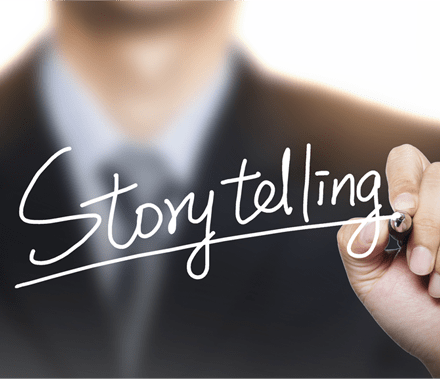A core part of branding and sales is your story. This is the story of your origin, you reason for being, and your ability to solve the prospective client’s problem. Many businesses have a rather generic framework to their sales story and it typically gravitates around them – how they got started, why they are so great, why clients should work with them, their team, their competitive advantages, and how you should buy from them.
But they have it all wrong. In a world of overwhelming information flow, where real solutions need to be rapidly identified and implemented, the end buyer doesn’t care about you and your story nearly as much as they care about their immediate challenge and how you can solve it. Just because most of your competitors have positioned themselves in the hero coming to the client’s rescue doesn’t make it the right approach.

In Joseph Campbell’s classic, The Hero’s Journey, we learn that every story has a hero. And this hero always has an obstacle that they must overcome with the help of a trusted guide who helps them transform during their pursuit of triumph.
Why then are we positioning ourselves as the hero? We are not the hero. Our prospective client is the real hero in their journey. That’s their role and what they care about, overcoming their challenge and transforming into something better.
But they have it all wrong. In a world of overwhelming information flow, where real solutions need to be rapidly identified and implemented, the end buyer doesn’t care about you and your story nearly as much as they care about their immediate challenge and how you can solve it. Just because most of your competitors have positioned themselves in the hero coming to the client’s rescue doesn’t make it the right approach.
But they need help. They need a guide, an expert, a trusted confidant who can take them through their obstacle. You are that expert, that guide, not the hero. A guide doesn’t push how great they are and constantly pitch themselves. Rather, they jump straight into their expertise and offer keen insights, help, and support.
A sales story that places both you and the prospective client in your proper roles reassures them that you are there to help, to provide them with best-in-class solutions and help them past whatever problem they are facing.
But to build this story, one that can pivot accordingly to multiple kinds of buyers and scenarios takes some work, strategy, and time. This article offers a cheat sheet approach to get the process going. Refinement will happen with working with professionals, and it will require testing of various versions until finalized.
1. Immediate: BRAND DNA
Creating a compelling sales story based on positioning the client as the hero and you as their guide, or trusted confidant. Adding tangible value is the name of the game, and the ability to articulate this in a meaningful way as to compel engagement is a must.
A brand DNA defines every core attribute of who you are, what you do, how you add value, and why it matters to your end client. The first and most important thing to do is position your clients as the heroes. It’s about them, it’s about empowering them, understanding them, empathizing with them. Instead of saying “Me, me, me” your narrative becomes “You, you, you.” We will help you shift the focus, internal culture and collateral to effectively communicate this new position.

The second important value provided by your brand DNA is identifying your hero’s obstacles. In other words, we will help you discover what it is your clients are really suffering from, and thus, what is it they really need. For instance, a client’s pain may be loss in sales due to competitors taking over market share. However, if you look deeper you may find that the actual pain is the fear of change and innovation, which leads to stagnation. Once you can address this deeper issue you have positioned yourself in the ultimate position to bring about lasting relief. It is not just about getting an aspirin to numb the headache, it is about getting to the root cause of the headache and eliminating that.
The third thing your brand DNA will do for you is identify both the positive and negative outcomes your clients will have from choosing to work or not work with you, respectively. Some sales people like to use scare tactics and focus on the worst-case scenario: “given all the uncertainty in the market right now, If we don’t come in to help, you’ll be out of business and bankrupt within the next 12 months.” This may come off sensational and deliver a punch, but the problem is that it takes away from your credibility and empathy as a guide.
You don’t want to coerce people into working with you. That just makes you seem manipulative. Building trust is an absolute must, and you must be as authentic as possible. As such, although it is important to mention what can happen in the future if pains are not addressed, this should be done in passing, and used as a condiment, not as the main dish. The main dish should be education and having your clients visualize the best-case scenario. For example, instead of scaring them with bankruptcy, you can tell them “If you work with us, we will boost your daily operational capacity by 40% in the next six months and provide up to 30% reduction in costs.” This is a much more inspirational (and authentic) way to identify your client’s outcome.
Your brand DNA must add value to an underlining client problem, in terms of actually offering to relieve it.
2. Holistic: Across ALL sales collateral
Creating a compelling sales story based on positioning the client as the hero and you as their guide, or trusted confidant. Adding tangible value is the name of the game, and the ability to articulate this in a meaningful way as to compel engagement is a must.
A brand DNA defines every core attribute of who you are, what you do, how you add value, and why it matters to your end client. The first and most important thing to do is position your clients as the heroes. It’s about them, it’s about empowering them, understanding them, empathizing with them. Instead of saying “Me, me, me” your narrative becomes “You, you, you.” We will help you shift the focus, internal culture and collateral to effectively communicate this new position.

Now that you have your brand DNA, which has identified your new narrative, positioning, your client’s pains, and the ways in which you can best present your value to clients, you must create cohesive sales collateral. Every interaction with your clients should be on brand and reflect the positioning in the brand DNA, whether it’s online via your website, through an ad, in person, or over the phone. The new positioning has to be implemented across every touchpoint for it to be effective. We can help you do just that. We will align all your sales collateral in a way that seamlessly reflects the Hero’s Journey of your clients.
Both your marketing and sales team must align on the new positioning to create and enhance assets, ranging from your sales call templates and your brand manifesto, to your follow-up protocols and your website. Your brand story must be not only a beautifully created narrative, but it must be implemented in an effective and visually impactful way. With every interaction, your clients will find themselves in the shoes of a hero going through a journey of exploration, overcoming obstacles, navigating an abyss and undergoing lasting transformation. And you will be the authentic, empathetic, wise guide who will lead them.
Once you have done this, the last touch in creating holistic sales collateral is strategically implementing calls to action, which are what will effectively close
the sale. These calls to action will be both direct and indirect. Direct ones will be featured on your website such as “Request Meeting” or “Schedule a Call.” We will also provide you with ways and strategies to ask direct calls to action in person and over the phone, as well as how to come back from “No” and “Maybe” in these scenarios. As for indirect calls to action, these can be a wide range of things like a free downloadable PDF, a free consultation, insightful blogs, and helpful email newsletters.. We will work with both your marketing and sales teams to align on the most effective ways, times, and means to transmit these indirect calls to action. Be sure to monitor the results of these calls to action using an evidence-based approach so that you can continuously improve and enhance them. Sales First!
After reading this, you probably realized that we are using the techniques we are preaching in this very article. We identified your core issue, which is the lack of a professional well-positioned sales story implementing the Hero’s Journey. We outlined the ways we can help you relieve the pain, and we have given you the results you can expect when working with us: clear and impactful narrative, cohesive sales collateral, effective value communication, strategies for closing clients, lean data monitoring, and ultimately – significant sales lifts. The indirect call to action is this article itself, as it provides a small dose of value-driven information for free.
This is a small example of a sales story in action. And you can have yours too. Schedule a meeting today to learn more about how Knightsbridge can help lift your sales through effective storytelling and sales collateral enhancement. (And yes, you guessed it – this is the direct call to action)

